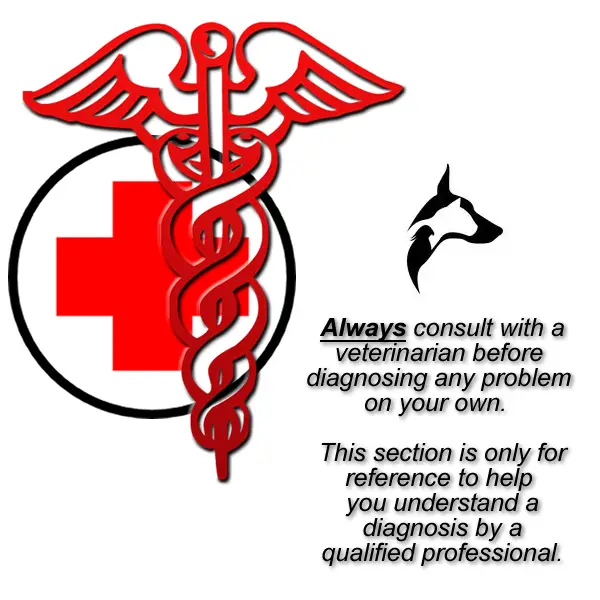Diagnosis
When symptoms indicate bladder stones, the first step is usually to take an x-ray. Most types of stones will appear readily in an x-ray, urate and occasionally cystine stones being the most common exceptions. Stones smaller than three millimeters may not be visible. Ultrasonography is also useful for identifying bladder stones. Crystals identified in a urinalysis may help identify the stones, but analysis of the stones is necessary for identification of the complete chemical composition.
Types of Bladder Stones
Struvite Stones
Struvite stones are also known as magnesium ammonium phosphate stones due to their chemical composition - MgNH4PO4·6H20. Often there is a small amount of calcium phosphate present. They form at a neutral to alkaline pH of the urine. Bacterial infections contribute to their formation by increasing the pH of the urine through the urease enzyme in dogs. More than 90 percent of dogs with struvite stones have an associated urease-producing bacterial infection in the urinary tract, but in cats struvite stones usually form in sterile urine. The appearance of the stones vary from large solitary stones to multiple smaller stones. They can assume the shape of the bladder or urethra.
Dissolution of the struvite stones depends on acidification of the urine through diet or urinary acidifiers. Special diets for dissolution also have reduced protein, phosphorus, and magnesium, as well as increased salt to increase water consumption and dilute the urine. The diet needs to be fed exclusively, but it can only be fed for a few months total due to potential side effects. Contraindications to this diet include heart failure, liver failure, kidney failure, pancreatitis, hypertension (high blood pressure), and hypoalbuminemia (low serum albumin). Prevention of struvite stones is with a similar diet with milder restrictions.
Certain dog breeds are predisposed to struvite stones, including Miniature Schnauzers, Bichon Frises, and Cocker Spaniels. They are the most commonly reported bladder stone in female dogs.
Calcium Oxalate Stones
Calcium oxalate stones form in an acidic to neutral urine. Two types naturally occur, calcium oxalate monohydrate, or whewellite (CaC2O4·H2O), and calcium oxalate dihydrate, or weddellite (CaC2O4·2H2O). Their appearance can be rough, smooth, spiculated, or jackstone. Calcium oxalate stones form more readily in animals with hypercalcaemia, which can caused by Addison's disease or certain types of cancer. Hypercalcaemia results in hypercalciuria, which can also be caused by Cushing's syndrome or hyperparathyroidism.
There is no recommended diet to dissolve calcium oxalate stones. For prevention a diet low in protein and oxalates and high in magnesium, phosphorus, and calcium is recommended. Increased dietary magnesium and phosphorus decreases the amount of calcium in the urine, and increased dietary calcium reduces absorption of oxalates from the intestines. Potassium citrate has been recommended as a preventative for calcium oxalate stone formation because it forms a soluble complex with oxalates and promotes the formation of alkaline urine.
Dog breeds possible prone to calcium oxalate stones include Miniature Schnauzers, Lhasa Apsos, Yorkshire Terriers, Miniature Poodles, Shih Tzus, and Bichon Frises. They are the most common stone in male dogs.
Urate Stones
Urate (C5H4N4O3) stones, usually ammonium urate (NH4·C5H4N4O3) or sodium urate monohydrate (Na·C5H4N4O3 —H2O), form in an acidic to neutral urine. They are usually small, yellow-brown, smooth stones. Urate stones form due to an increased excretion of uric acid in the urine. Dalmatians (especially males) and to a lesser extent Bulldogs are genetically predisposed to the formation of urate stones because of an altered metabolism of purines. Dalmatians have a decreased rate of urate hepatic transport, leading to only about 30 to 40 percent conversion of urate to allantoin, compared with greater than 90 percent conversion in other breeds. Dogs with portosystemic shunts or endstage liver disease also have increased uric acid excretion in the urine due to reduced conversion of uric acid to allantoin and ammonia to urea.
Urate stones can be dissolved using a diet with reduced purines that alkalinizes and dilutes the urine. Allopurinol is used in dogs with altered purine metabolism to prevent the formation of uric acid. Feeding a diet high in purines while simultaneously administering allopurinol can result in the formation of xanthine (C5H4N4O2) stones.
Cystine Stones
Cystine ((SCH2CHNH2COOH)2) stones form in an acidic to neutral urine. They are usually smooth and round. They are caused by increased urine excretion of cystine (a relatively insoluble amino acid) in dogs with a defect in renal tubule reabsorption of cystine. Dietary reduction of protein and alkalinization of the urine may help prevent formation. Medications such as D-penicillamine and 2-MPG contain thiol, which forms a soluble complex with cystine in the urine. Dog breeds possibly predisposed to formation of cystine stones include Bulldogs, Dachshunds, Basset Hounds, Chihuahuas, Yorkshire Terriers, Irish Terriers, and Newfoundlands. In Newfoundlands, cystinuria is inherited as an autosomal recessive trait, but in the other breeds it is a sex linked trait and found primarily in male dogs.
Calcium Phosphate Stones
Calcium phosphate, also known as hydroxyapatite (Ca10(PO4)6(OH)2), stones form in neutral to alkaline urine. They are usually smooth and round. Calcium phosphate is usually a component of struvite or calcium oxalate stones and is infrequently a pure stone. They form more readily with hypercalcaemia. Dog breeds possibly predisposed to calcium phosphate stone formation include Yorkshire Terriers, Miniature Schnauzers, and Cocker Spaniels.
Silicate Stones
Silicate (SiO2) stones form in acidic to neutral urine. They are usually jackstone in appearance. There is possibly an increased incidence associated with dogs on diets that have a large amount of corn gluten or soybean hulls. Dog breeds possibly predisposed include German Shepherd Dogs, Golden Retrievers , Labrador Retrievers, and Miniature Schnauzers.
Treatment
Reasons for treatment of bladder stones include recurring symptoms and risk of urinary tract obstruction. Some stones can be dissolved using dietary modifications and/or medications. Small stones in female dogs may possibly be removed by urohydropropulsion, a nonsurgical procedure. Urohydropropulsion is performed under sedation by filling the bladder with saline through a catheter, holding the dog vertically, and squeezing the bladder to expel the stones through the urethra. Bladder stones can be removed surgically by a cystotomy, opening of the bladder. Stones lodged in the urethra can often be flushed into the bladder and removed, but sometimes a urethrotomy is necessary. In male dogs with recurrent urinary tract obstruction a scrotal urethrostomy creates a permanent opening in the urethra proximal to the area where most stones lodge, behind the os penis. In male cats, stones lodge where the urethra narrows in the penis. Recurrent cases can be treated surgically with a perineal urethrostomy, which removes the penis and creates a new opening for the urethra.
To prevent recurrence of stones, special diets can be used for each type of stone. Increasing water consumption by the animal dilutes the urine, which prevents oversaturation of the urine with crystals.






